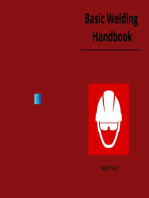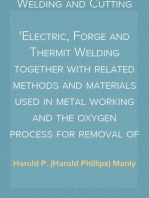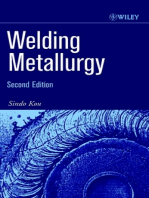X17Crni 16-2: C: 0,19 - 0,22 CR: 15,5 - 17,0 Ni: 1,5 - 2,5
X17Crni 16-2: C: 0,19 - 0,22 CR: 15,5 - 17,0 Ni: 1,5 - 2,5
Uploaded by
Aadhya engineering ServicesCopyright:
Available Formats
X17Crni 16-2: C: 0,19 - 0,22 CR: 15,5 - 17,0 Ni: 1,5 - 2,5
X17Crni 16-2: C: 0,19 - 0,22 CR: 15,5 - 17,0 Ni: 1,5 - 2,5
Uploaded by
Aadhya engineering ServicesOriginal Title
Copyright
Available Formats
Share this document
Did you find this document useful?
Is this content inappropriate?
Copyright:
Available Formats
X17Crni 16-2: C: 0,19 - 0,22 CR: 15,5 - 17,0 Ni: 1,5 - 2,5
X17Crni 16-2: C: 0,19 - 0,22 CR: 15,5 - 17,0 Ni: 1,5 - 2,5
Uploaded by
Aadhya engineering ServicesCopyright:
Available Formats
C: 0,19 - 0,22
Cr: 15,5 - 17,0
Ni: 1,5 - 2,5
1.4057
X17CrNi 16-2
Typical applications
1.4057 - automotive industry
- chemical industry
Chromium-nickel martensitic stainless steel - aerospace industry
with nickel addition - petrochemical industry
- mechanical engineering
Relevant current and obsolete standards: Hint: - available from stock
· EN 10088-3 : 1.4057 X17CrNi 16-2
· AISI : 431 Processing
· BS : 321S31 - automated machining : seldom
431 S 29 - machinable : yes
· JIS : 431 - hammer and die forging : seldom
· AFNOR : Z15CN16-02 - cold forming : yes
· DIN 17440 : 1.4057 - cold heading : not common
· SIS : 2321 - suited to polishing : yes
· Luftfahrt : WL 4044
Finished product forms and conditions
General properties · wire rod Æ 5,5 – 27
· peeled bars Æ 5,5 - 78
- corrosion resistance : good
· bright bar h9, Æ 5 - 78
- mechanical properties : good
· bright coils h9, Æ 5 – 20
- forgeability : average
· solution annealed
- weldability : good
· tempered
- machinability : poor
· pickled
· drawn
Special properties
· straightened
- can be used to temperatures around 400 °C · peeled
- ferromagnetic grade · ground
Physical properties Demand tendency ä
3
- density (kg/dm ) : 7,7
- electrical resistivity 1.4057 is most commonly used in applications
2
at 20°C (W mm /m) : 0,70 where the 12% chromium steels do not exhibit
- magnetisable : yes sufficient resistance to corrosion or when the
- thermal conductivity toughness of the 12% martensitic stainless steels
at 20°C (W/m K) : 25 is not sufficient.
- specific heat capacity
at 20°C (J/kg K) : 460 Corrosion resistance (PRE = 17.5 to 21.26)
- thermal expansion The formation of chromium carbides and the
-6 -1
(10 K ) between associated chromium depleted regions that form
20 and 100°C : 10 around these precipitates make this grade of
20 and 200°C : 10,5 steel susceptible to intergranular corrosion.
20 and 300°C : 10,5
20 and 400°C : 10,5 Surface condition plays an important role in the
corrosion resistance of this steel with polished
surfaces exhibiting far superior corrosion resis-
tance compared with rougher surfaces on the
same material.
Revision No. 4057-0
Created: 04.07.2000
Properties, applications and processing
re-heat treated. When the mechanical properties
Heat treatment / mechanical properties are not of primary concern,
Annealed condition:
1.4057 can be soft annealed by holding at a tem- then Novonitâ 4430 or 4370 can be used as the
perature in the range 680 to 800°C followed by filler material. When these two fillers are used,
slow cooling in an oven or air. In this condition, pre-heating of the work piece is not required.
the following mechanical properties can be ex- Care must be taken to ensure that no nitrogen or
pected: carbon containing gasses are used for the shield-
ing gas since this can adversely affect the
Property Specification properties of the weldment. To ensure adequate
- tensile strength (N/mm2) Rm : £ 950 corrosion resistance of the weldment, any spatter
- hardness HB : £ 295 or heat tint must be removed.
Note: the HB values could be 60 units higher and the tensile
strengths 150 N/mm2 higher due to cold work during straight- Elevated temperature properties
ening of profiles £ 35mm. The following minimum tensile properties at vari-
ous temperatures are specified in the EN 10088-
1.4057 can be hardened by holding at a tempera- 3 : 1995 standard.
ture between 950 - 1060°C followed by cooling in
air or oil. 600
575
Tempering: The tempering temperature is de- 550
Minimum proof stress (N/mm )
2
pendent on the desired strength. Since this grade 525
QT 900
of steel is susceptible to 475°C embrittlement, 500
care must be taken to limit exposure to the tem- 475
perature range 420 to 520°C, both during fabrica- 450
QT 800
tion and service. 425
400
Two heat treated conditions are usually specified, 375
namely: QT800 (tempered between 750 and 350
50
100
150
200
250
300
350
400
450
800°C followed by a second tempering treatment Forging Test temperature ( C)
†
between 650 and 700°C) and QT900 (tempered
Care should be taken when forging since 1.4057,
between 600 and 650°C). The number behind
since gradual heating to a temperature of about
the designation QT relates to the minimum ten-
850°C is recommended prior to more rapid heat-
sile strength. In these conditions, the following
ing to a temperature of between 1150 and
mechanical properties can be expected:
1180°C. Forging then takes place between 1180
Property Spec. QT800 Typical - 950°C followed by slow cooling is an oven or in
- yield strength (N/mm2) Rp0,2 : ³ 600 620 dry ash or similar material to promote slow cool-
- tensile strength (N/mm2) Rm : 800 - 950 820 ing.
- tensile elongation (%) A5 : ³ 14 20
- impact energy (J) @ 25°C ISO-V : ³ 25 Machining
Property Spec. QT900 Typical The machinability of this grade of stainless steel
- yield strength (N/mm2) Rp0,2 : ³ 700 710 is directly related to its hardness. 1.4057 ma-
- tensile strength (N/mm2) Rm : 900 - 1050 920 chines similar to carbon steels of the same hard-
- tensile elongation (%) A5 : ³ 12 16 ness. Although it must be realised that the ma-
- impact energy (J) @ 25°C ISO-V : ³ 20
chining parameters will vary depending on the
† structure/hardness of the steel, the following pa-
Should the nickel content be on the lower end of the speci-
fication, then a simple tempering treatment at a temperature rameters can be used as a guideline when using
between 620 and 720°C will be sufficient. coated hardmetal cutting tools:
tensile strengths depth of cut (mm)
feed (mm/rev)
Welding Rm in N/mm2 6 mm 3 mm 1 mm
0,5 mm/r 0,4 mm/r 0,2 mm/r
When welding 1.4057 with a matching filler, the
annealed (700 - 800) 100 m/min 130 m/min 165 m/min
work piece is usually heated to a temperature of
between 100 and 300°C prior to welding and is
tempered as soon as possible after welding to
restore some ductility to the weld zone. For op-
timal properties, the entire work piece should be
Revision No. 4057-0
Created: 04.07.2000
You might also like
- Tile Works: Calculations Floor To Be EstimatedNo ratings yetTile Works: Calculations Floor To Be Estimated24 pages
- X65Cr13 C 0.58 - 0.70 CR 12.50 - 14.50 S Max. 0.015No ratings yetX65Cr13 C 0.58 - 0.70 CR 12.50 - 14.50 S Max. 0.0152 pages
- The Essentials of Material Science and Technology for EngineersFrom EverandThe Essentials of Material Science and Technology for Engineers5/5 (1)
- Aalco Metals LTD Stainless Steel 14021 Bar 311No ratings yetAalco Metals LTD Stainless Steel 14021 Bar 3112 pages
- EN 1 4835 - 1510 Valbruna Nordic EnglishNo ratings yetEN 1 4835 - 1510 Valbruna Nordic English2 pages
- En 1 4305 - 1408 Valbruna Nordic EnglishNo ratings yetEn 1 4305 - 1408 Valbruna Nordic English2 pages
- High Quality Products For Welding and Cladding100% (1)High Quality Products For Welding and Cladding25 pages
- Remanit: Stainless, Acid and Heat-Resistant Special Steel Grades À La CarteNo ratings yetRemanit: Stainless, Acid and Heat-Resistant Special Steel Grades À La Carte36 pages
- Structural Stainless Steel Designing With Stainless Steel: Ing. Maarten FortanNo ratings yetStructural Stainless Steel Designing With Stainless Steel: Ing. Maarten Fortan153 pages
- Steel Casting Handbook Supplement 8 - High Alloy Data Sheets - Corrosion SeriesNo ratings yetSteel Casting Handbook Supplement 8 - High Alloy Data Sheets - Corrosion Series93 pages
- High Tensile: Voestalpine High Performance Metals (Australia) Pty LTDNo ratings yetHigh Tensile: Voestalpine High Performance Metals (Australia) Pty LTD5 pages
- Thermanit Nicro 82: TIG Rods, Nickel-AlloyNo ratings yetThermanit Nicro 82: TIG Rods, Nickel-Alloy2 pages
- Duplex Stainless Steel EN 1.4460 MAXIVAL®No ratings yetDuplex Stainless Steel EN 1.4460 MAXIVAL®2 pages
- Type and Selection of Welding ConsumablesNo ratings yetType and Selection of Welding Consumables11 pages
- Recommended Materials To Be Used in Replacement and Re-Construction100% (1)Recommended Materials To Be Used in Replacement and Re-Construction9 pages
- Oxy-Acetylene Welding and Cutting Electric, Forge and Thermit Welding together with related methods and materials used in metal working and the oxygen process for removal of carbonFrom EverandOxy-Acetylene Welding and Cutting Electric, Forge and Thermit Welding together with related methods and materials used in metal working and the oxygen process for removal of carbonNo ratings yet
- Boiler Making for Boiler Makers - A Practical Treatise on Work in the ShopFrom EverandBoiler Making for Boiler Makers - A Practical Treatise on Work in the Shop4.5/5 (2)
- Principles of Welding: Processes, Physics, Chemistry, and MetallurgyFrom EverandPrinciples of Welding: Processes, Physics, Chemistry, and Metallurgy4/5 (1)
- Proceedings of the 8th International Symposium on Superalloy 718 and DerivativesFrom EverandProceedings of the 8th International Symposium on Superalloy 718 and DerivativesNo ratings yet
- Soft Rectangular and Square Bare Copper Wire For Electrical ConductorsNo ratings yetSoft Rectangular and Square Bare Copper Wire For Electrical Conductors6 pages
- Copper-Silicon Alloy Wire For General ApplicationsNo ratings yetCopper-Silicon Alloy Wire For General Applications3 pages
- Seamless Copper Tube, Bright Annealed: Standard Specification ForNo ratings yetSeamless Copper Tube, Bright Annealed: Standard Specification For5 pages
- Aluminum For Use in Iron and Steel ManufactureNo ratings yetAluminum For Use in Iron and Steel Manufacture4 pages
- Welded Copper and Copper-Alloy Condenser and Heat Exchanger Tubes With Integral FinsNo ratings yetWelded Copper and Copper-Alloy Condenser and Heat Exchanger Tubes With Integral Fins9 pages
- Extra-High-Strength and Ultra-High-Strength Zinc-Coated (Galvanized) Steel Core Wire For Overhead Electrical ConductorsNo ratings yetExtra-High-Strength and Ultra-High-Strength Zinc-Coated (Galvanized) Steel Core Wire For Overhead Electrical Conductors4 pages
- Copper-Zinc-Tin-Bismuth Alloy Rod, Bar and Wire: Standard Specification ForNo ratings yetCopper-Zinc-Tin-Bismuth Alloy Rod, Bar and Wire: Standard Specification For4 pages
- High Performance Tin-Coated Annealed Copper Wire Intended For Electrical and Electronic Application For SolderabilityNo ratings yetHigh Performance Tin-Coated Annealed Copper Wire Intended For Electrical and Electronic Application For Solderability7 pages
- Oil Content, Oil-Impregnation Efficiency, and Interconnected Porosity of Sintered Powder Metallurgy (PM) Products Using Archimedes' PrincipleNo ratings yetOil Content, Oil-Impregnation Efficiency, and Interconnected Porosity of Sintered Powder Metallurgy (PM) Products Using Archimedes' Principle5 pages
- Pmi Test Report: Test Report No: AES/PMI/179 M/s Albatraoz Technologies India Private LimitedNo ratings yetPmi Test Report: Test Report No: AES/PMI/179 M/s Albatraoz Technologies India Private Limited1 page
- ST5001 Maintenance and Rehabilitation of Structures100% (1)ST5001 Maintenance and Rehabilitation of Structures2 pages
- Documents Referenced in Appendix A of The National Plumbing Code of Canada 2005 Table A-1.3.1.2.No ratings yetDocuments Referenced in Appendix A of The National Plumbing Code of Canada 2005 Table A-1.3.1.2.6 pages
- Lecture 1 and 3 - Brief Introduction and Casting FundamentalNo ratings yetLecture 1 and 3 - Brief Introduction and Casting Fundamental69 pages
- 07 - Welding Ultra High Strength SteelsNo ratings yet07 - Welding Ultra High Strength Steels17 pages
- Behavior of The Magnetic Abrasive Tool For Cutting Edge PDFNo ratings yetBehavior of The Magnetic Abrasive Tool For Cutting Edge PDF7 pages
- Brickwork: Definition and Important TermsNo ratings yetBrickwork: Definition and Important Terms3 pages









































































































